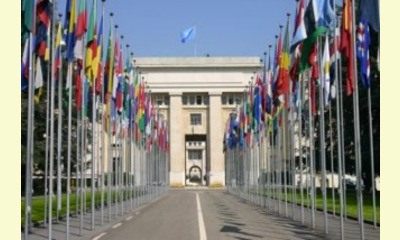|
|
Culture of Peace Advocacy at the UN: Education about Peace Education
an article by Oliver Rizzi Carlson
The official international efforts for the creation of a culture
of peace include the International Year for a Culture of Peace, the
Declaration and Programme of Action on a Culture of Peace, and the
Decade for a Culture of Peace, which ended just last year. They come
from UNESCO and the UN itself, and serve as tools and stepping-stones to
promote peace education policies within the UN now and into the future.

click on photo to enlarge
This
year, peacemaking and peacebuilding traditions were taken into account
during a consultation of the UN Office of the High Commissioner on Human
Rights about cultural rights and heritage; peace education and
empowerment were promoted within the context of a report on violence
against children as well as a draft resolution on children living and or
working on the street; and synergies were created for the promotion of
the Declaration on Human Rights Education and Training adopted at the
Human Rights Council last month – to cite just a few examples.
With the creation of a Culture of Peace Working Group in Geneva,
we are now working together with other NGOs to focus on the Human Right
to Peace. The Advisory Committee of the Human Rights Council is to
prepare a draft declaration on the right of peoples to peace.
The Advisory Committee states in its progress report that “a
right to peacewithout reference to education is inconceivable,” mentions
education as a “necessity for building a culture of peace" and states
that “all peoples and individuals have a right to comprehensive peace
education.”
It is now up to us to make sure that these considerations are
given real import in the drafting of the declaration, and that they are
infused with content and a substantial understanding of those concepts.
Through these efforts, we are supporting policy makers in
supporting peace educators – what I call “the process to the process.”
We are working with institutions to create the political infrastructure
to enable and facilitate the processes of peace education. And it is a
growing number of us contributing our stream to the river on which peace
education will be increasingly recognized and supported at the
institutional level, making it a guiding principle and a way of living
for the current and future generations.
|








|
DISCUSSION
Question(s) related to this article:
Peace education at the United Nations
how does it work?
Thematic forum(s) in which this article is being discussed:
PEACE EDUCATION - EDUCATION POUR LA PAIX - EDUCACION PARA LA PAZ
LATEST READER COMMENT:
[Editor's note]: This is a continuation of the article by Oliver Rizzi Carlson listed above.
In
the historic, international hallways of the United Nations, multitudes
of people from every country in the world are busy going to meetings,
addressing agenda items relevant to their governments and organizations,
and making contacts. Lists are set, events are scheduled… agendas are
largely inherited and predictable, presenting many issues and objectives
that people have been working toward for a long time: goals of peace,
prosperity, equality, justice. And yet, agendas still provide an
incredible space to speak about the process by which those desires are
achievable. Most of the time, documents just fall short of that
transformative element, seeming to be longing for it. Peace education is
seldom included; but once mentioned, it is immediately recognized for
its relevance and importance. The “whats” are many and detailed in the
world of international conference-making; the expertise of the “how” is a
welcome newcomer to the discussion.
Advocating for peace
education in the midst of governments, international organizations and
even NGOs, few of which promote peace education directly, appears as a
lonely journey.. . ...more.

|
|
|
This report was posted on May 22, 2011.
If you wish to start a new discussion topic on this article, please copy the title of this article which is Culture of Peace Advocacy at the UN: Education about Peace Education and its number which is 477 and enter this information along with your discussion question and an introductory response to the question here.

A few stories are retained on the main listings if they are considered
by readers to be a priority. If you have not already done so, please
take the time to check a box below: should this article be considered as
a priority?

|








